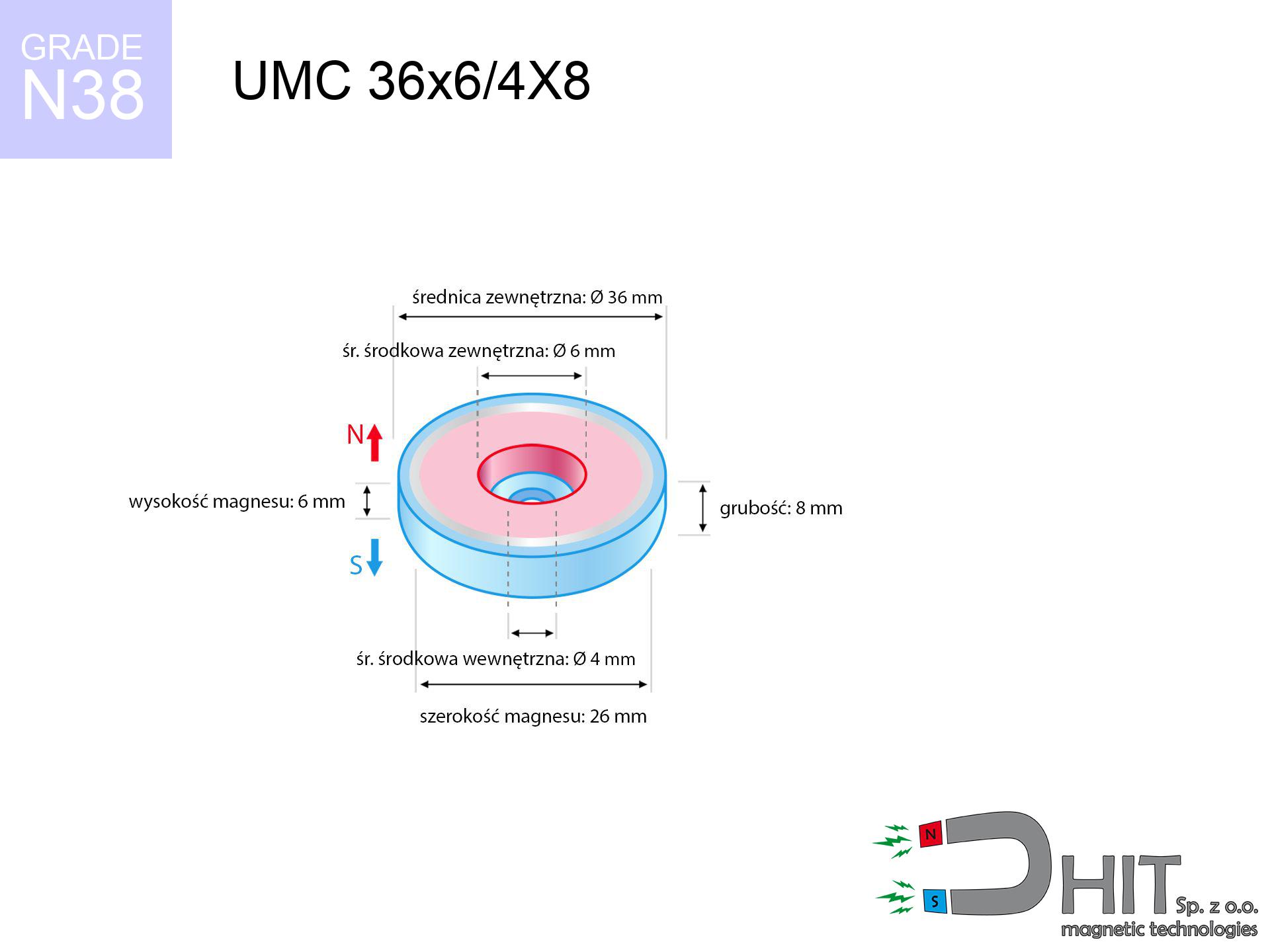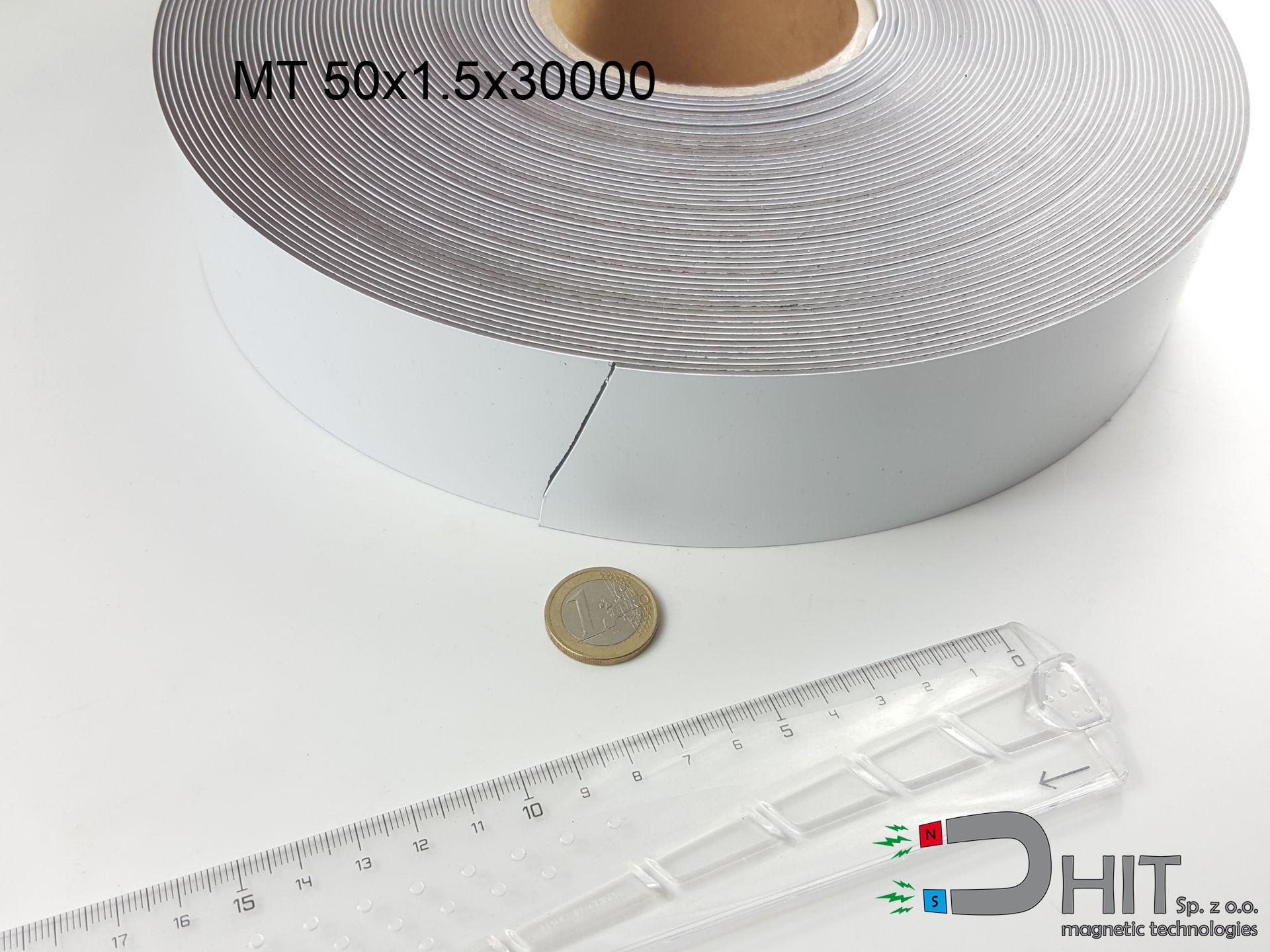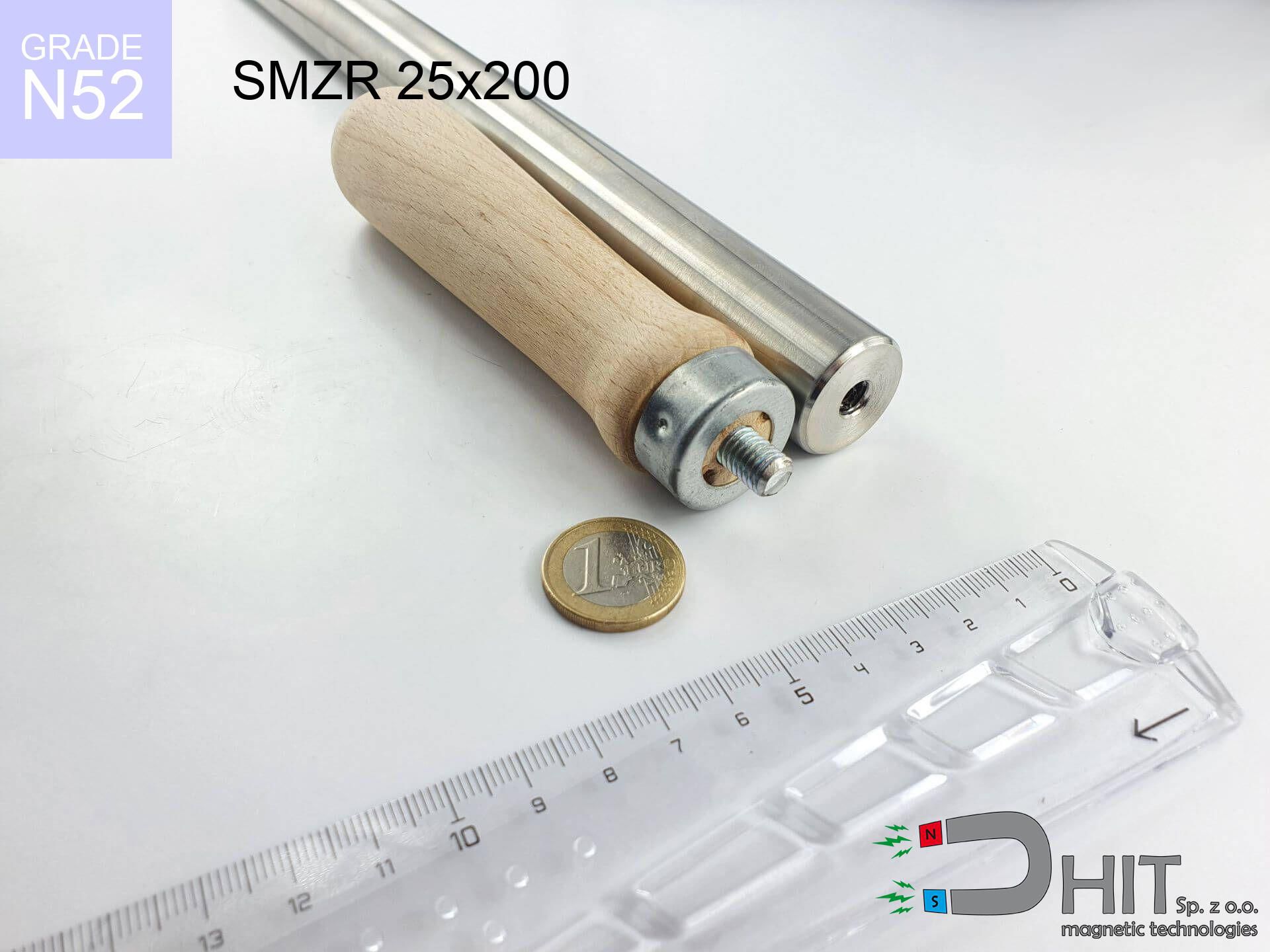UMC 36x6/4X8 / N38 - cylindrical magnetic holder
cylindrical magnetic holder
Catalog no 320410
GTIN/EAN: 5906301814665
Diameter
36 mm [±1 mm]
internal diameter Ø
6/4 mm [±1 mm]
Height
8 mm [±1 mm]
Weight
45 g
Load capacity
29.00 kg / 284.39 N
Coating
[NiCuNi] Nickel
21.49 ZŁ with VAT / pcs + price for transport
17.47 ZŁ net + 23% VAT / pcs
bulk discounts:
Need more?
Give us a call
+48 888 99 98 98
or drop us a message by means of
contact form
our website.
Specifications as well as structure of neodymium magnets can be reviewed on our
our magnetic calculator.
Order by 14:00 and we’ll ship today!
Technical specification - UMC 36x6/4X8 / N38 - cylindrical magnetic holder
Specification / characteristics - UMC 36x6/4X8 / N38 - cylindrical magnetic holder
| properties | values |
|---|---|
| Cat. no. | 320410 |
| GTIN/EAN | 5906301814665 |
| Production/Distribution | Dhit sp. z o.o. |
| Country of origin | Poland / China / Germany |
| Customs code | 85059029 |
| Diameter | 36 mm [±1 mm] |
| internal diameter Ø | 6/4 mm [±1 mm] |
| Height | 8 mm [±1 mm] |
| Weight | 45 g |
| Load capacity ~ ? | 29.00 kg / 284.39 N |
| Coating | [NiCuNi] Nickel |
| Manufacturing Tolerance | ±1 mm |
Magnetic properties of material N38
| properties | values | units |
|---|---|---|
| remenance Br [min. - max.] ? | 12.2-12.6 | kGs |
| remenance Br [min. - max.] ? | 1220-1260 | mT |
| coercivity bHc ? | 10.8-11.5 | kOe |
| coercivity bHc ? | 860-915 | kA/m |
| actual internal force iHc | ≥ 12 | kOe |
| actual internal force iHc | ≥ 955 | kA/m |
| energy density [min. - max.] ? | 36-38 | BH max MGOe |
| energy density [min. - max.] ? | 287-303 | BH max KJ/m |
| max. temperature ? | ≤ 80 | °C |
Physical properties of sintered neodymium magnets Nd2Fe14B at 20°C
| properties | values | units |
|---|---|---|
| Vickers hardness | ≥550 | Hv |
| Density | ≥7.4 | g/cm3 |
| Curie Temperature TC | 312 - 380 | °C |
| Curie Temperature TF | 593 - 716 | °F |
| Specific resistance | 150 | μΩ⋅cm |
| Bending strength | 250 | MPa |
| Compressive strength | 1000~1100 | MPa |
| Thermal expansion parallel (∥) to orientation (M) | (3-4) x 10-6 | °C-1 |
| Thermal expansion perpendicular (⊥) to orientation (M) | -(1-3) x 10-6 | °C-1 |
| Young's modulus | 1.7 x 104 | kg/mm² |
Chemical composition
| iron (Fe) | 64% – 68% |
| neodymium (Nd) | 29% – 32% |
| boron (B) | 1.1% – 1.2% |
| dysprosium (Dy) | 0.5% – 2.0% |
| coating (Ni-Cu-Ni) | < 0.05% |
Environmental data
| recyclability (EoL) | 100% |
| recycled raw materials | ~10% (pre-cons) |
| carbon footprint | low / zredukowany |
| waste code (EWC) | 16 02 16 |
View more offers
Advantages and disadvantages of rare earth magnets.
Strengths
- Their magnetic field remains stable, and after around 10 years it drops only by ~1% (theoretically),
- Magnets very well defend themselves against demagnetization caused by ambient magnetic noise,
- In other words, due to the aesthetic layer of silver, the element gains visual value,
- They feature high magnetic induction at the operating surface, making them more effective,
- Due to their durability and thermal resistance, neodymium magnets are capable of operate (depending on the form) even at high temperatures reaching 230°C or more...
- Thanks to versatility in constructing and the capacity to customize to client solutions,
- Key role in advanced technology sectors – they serve a role in magnetic memories, electric motors, diagnostic systems, also other advanced devices.
- Thanks to concentrated force, small magnets offer high operating force, in miniature format,
Weaknesses
- At very strong impacts they can crack, therefore we recommend placing them in special holders. A metal housing provides additional protection against damage, as well as increases the magnet's durability.
- When exposed to high temperature, neodymium magnets suffer a drop in strength. Often, when the temperature exceeds 80°C, their power decreases (depending on the size and shape of the magnet). For those who need magnets for extreme conditions, we offer [AH] versions withstanding up to 230°C
- Magnets exposed to a humid environment can rust. Therefore when using outdoors, we recommend using waterproof magnets made of rubber, plastic or other material resistant to moisture
- We suggest casing - magnetic holder, due to difficulties in realizing nuts inside the magnet and complicated shapes.
- Possible danger to health – tiny shards of magnets can be dangerous, when accidentally swallowed, which gains importance in the aspect of protecting the youngest. Furthermore, small components of these magnets are able to complicate diagnosis medical when they are in the body.
- With large orders the cost of neodymium magnets is economically unviable,
Pull force analysis
Detachment force of the magnet in optimal conditions – what contributes to it?
- on a base made of structural steel, optimally conducting the magnetic field
- with a cross-section of at least 10 mm
- characterized by lack of roughness
- under conditions of ideal adhesion (metal-to-metal)
- during pulling in a direction vertical to the mounting surface
- at room temperature
Magnet lifting force in use – key factors
- Clearance – the presence of foreign body (paint, tape, gap) interrupts the magnetic circuit, which reduces capacity steeply (even by 50% at 0.5 mm).
- Pull-off angle – remember that the magnet holds strongest perpendicularly. Under sliding down, the holding force drops drastically, often to levels of 20-30% of the nominal value.
- Element thickness – for full efficiency, the steel must be adequately massive. Thin sheet limits the lifting capacity (the magnet "punches through" it).
- Material composition – different alloys attracts identically. Alloy additives weaken the attraction effect.
- Surface condition – ground elements guarantee perfect abutment, which improves force. Uneven metal reduce efficiency.
- Temperature – temperature increase causes a temporary drop of force. Check the thermal limit for a given model.
Holding force was measured on a smooth steel plate of 20 mm thickness, when a perpendicular force was applied, whereas under shearing force the lifting capacity is smaller. In addition, even a minimal clearance between the magnet’s surface and the plate decreases the load capacity.
Warnings
Heat sensitivity
Do not overheat. Neodymium magnets are susceptible to temperature. If you need resistance above 80°C, inquire about HT versions (H, SH, UH).
This is not a toy
Absolutely keep magnets out of reach of children. Ingestion danger is high, and the effects of magnets connecting inside the body are fatal.
Protect data
Do not bring magnets close to a wallet, computer, or TV. The magnetic field can irreversibly ruin these devices and wipe information from cards.
Handling rules
Handle magnets consciously. Their huge power can surprise even professionals. Stay alert and do not underestimate their power.
Flammability
Combustion risk: Rare earth powder is highly flammable. Do not process magnets in home conditions as this may cause fire.
Protective goggles
Neodymium magnets are ceramic materials, which means they are very brittle. Impact of two magnets will cause them breaking into small pieces.
Implant safety
Medical warning: Strong magnets can deactivate heart devices and defibrillators. Stay away if you have medical devices.
Nickel allergy
Nickel alert: The Ni-Cu-Ni coating contains nickel. If redness occurs, immediately stop working with magnets and wear gloves.
Compass and GPS
A strong magnetic field disrupts the operation of compasses in smartphones and GPS navigation. Maintain magnets close to a device to avoid damaging the sensors.
Bodily injuries
Large magnets can smash fingers instantly. Under no circumstances place your hand betwixt two attracting surfaces.






![SM 32x100 [2xM8] / N52 - magnetic separator SM 32x100 [2xM8] / N52 - magnetic separator](https://cdn3.dhit.pl/graphics/products/sm-32x100-2xm8-war.jpg)


